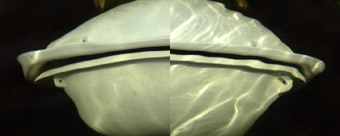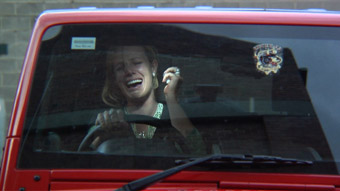To graft general, spatialised time onto subjective time is to forget that time is learnt; we are subjected to rationalised time but have a fundamentally asymmetrical relationship to it. Time takes time. After all, there was a time at the beginning for all of us when we didn’t know time. It is subject to our erratic unfolding consciousness, constantly oscillating with forgotten unconscious imperatives.
That universal mathematical time is a fantasy embodied in the movie camera underlies the formal concerns of Derek Hart’s video art. Reductive, looped, narrative structures—the synthetic thread between here and there; to and from; back and forth—are matched by the artist’s theoretical concerns with the back and forth between the screen and the spectator.
Hart acquired his training in the UK, receiving an MA in Fine Art from Chelsea College of Art in 2000. His admiration for the traditions of experimental film and video began when he was an undergraduate student of Time-Based Media at the Kent Institute of Art and Design. During the last five years he has exhibited both in Tasmania and nationally and has extended his practice to include site specific installation and curating. Currently undertaking an Australia Council, Inter-Art Connections Residency, hosted by Hydro Tasmania, Hart is in the process of making a number of works that document water flow in the state’s rivers, lakes and catchment areas. They will combine elemental time with the temporal tracking of two machines—the camera and an Acoustic Doppler Current Profiler (ADCP), used by Hydro Tasmania to collect hydrology data.
This alignment of technologies with a ‘found’ source of temporal flow is perfectly suited to Hart’s structural affinities and also discloses film’s scientific roots. He sets up a dialogue with hydrology, mimicking its research methodologies, which are designed to monitor environmental impact and water flow. Here the camera betrays its complicity as an homogenising apparatus filtering particular data requirements. Hart seems to be making reference to the belief, prevalent in mid-20th century film theory, that the camera is of itself irretrievably ideologically bound to a repressive Enlightenment past. Certainly, in a project that merges dispassionate mechanical and natural temporal flow, the connection is there. In fact, Hart’s interest in experimental filmmaking is made evident in all his work through his attempts to highlight the ambiguities of temporal synchronicity and repetition.
The ADCP is a sophisticated sonar machine that crosses waterways collecting readings of underwater topography and water velocity. The concept of sonar producing images through a cyclical emission and reception of sound waves parallels Hart’s formal and technical interests. His residency projects are in their early stages but he intends to attach cameras to the ADCP machine, augmenting its sensory range. Setting it off down rivers and around lakes, becoming the ADCP with a movie camera, à la Dziga Vertov.
The rhythmic pulsations of the sonar are not just a useful metaphor in describing Hart’s formal approach; they also illustrate a fundamental principle concerning our basic scientific relation to reality. The origins of physics have been thought to stem from observation, over centuries, of the cyclical return of the stars to the same place. Reality, then, is the rhythmic return of an object. In psychoanalytic terms the continual regaining of the object is a desire that is set in motion due to a primal lost object. As Lacan writes, “[r]eality faces man—and that is what interests him in it—both as having already been structured and as being that which presents itself in his experience as something that always returns to the same place” (The Ethics of Psychoanalysis). Hart’s consistent use of variations of the looped video creates an intriguing affinity with these ideas.
 |
Bivalve (2008), Derek Hart courtesy the artist |
Much has been written of the narcissistic identification that occurs watching film at the cinema; the hypnotic diegetic glue that you give yourself up to. Narrative identification is brought to the works by default but the way Hart utilises the loop stifles it; generally the editing is invisible and the point of view static. Gestures and movements that can fold in on themselves (be edited backwards and forwards seamlessly) are central elements around which the cyclical form of these works revolves.
 |
Sound Blocks Pain (2008) written & produced by Yvette Blackwood and directed by LX McGee |
These videos are more complex, formally and psychologically, than his earlier appropriation works, combining apparent and hidden temporalities. In Eclipse, a black screen lightens to reveal an emotionally distraught woman seen through the windscreen of a car. She is shaking the fist of her left hand with varying intensity. At the height of her grief and anger she is clearly screaming (although the film is silent) and her whole body shakes, the image fading to black again only to return to the start as if merely a shadow had passed briefly over her eternal misery. This work takes the form of a palindrome and actually begins at the end of the original film running backwards; it then runs forwards and so on. However, from the viewer’s temporal perspective the symmetry is false; the film can only ever run forwards.
Disruption of symmetry is also disclosed in a more complex way in Sitting Room. Two women and a man are sitting in a lounge room; a tense surly atmosphere is suggested through their silent, nervous mannerisms. Repetitive gestures of leg swinging, eating and drumming a wine glass are basically all they do, as if unconsciously revealing something through body language. This repeated short segment appears just as it would in the original but in order for the artist to maintain the looped suspension he has divided the screen three ways, one segment for each person. They share a diegetic space but are in fact living in three entirely different time zones, backwards and forwards independently; diegetic time becomes a mise en abyme, an interlacing of multiple quasi-narratives. The filmic object is sutured but when a bottle moves toward the hand of the man the spell is broken.
Philip Watkins is a contemporary arts writer and curator. He writes for various national journals and is currently Exhibition Coordinator for the Hobart City Council’s Carnegie Gallery.
Video excerpt, Sitting Room (2009) Derek Hart.
RealTime issue #94 Dec-Jan 2009 pg. 51
© Philip Watkins; for permission to reproduce apply to [email protected]








 back
back